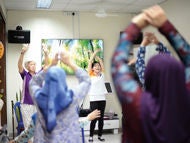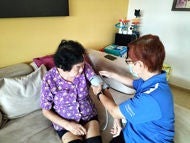
Mr Muhammad Zaki Saifee was diagnosed with sciatica at age 26 and had a herniated disc pressing on a nerve, causing the condition.
ST PHOTO: NG SOR LUAN
SINGAPORE – In 2021, after months of inactivity during the Covid-19 pandemic, Mr Muhammad Zaki Saifee decided to hit the gym.
He attempted a set of dumbbell lunges, then woke up the next day with searing pain radiating from his lower back to his left calf.
“It was a seven out of 10 kind of pain,” says Mr Zaki, 28. “I thought it was just because I hadn’t exercised in a long time, so I brushed it off.”
For the next few years, the pain recurred every few months, usually after intense workouts following a period of rest.
But in early 2024, the discomfort escalated into something more serious. While at work, Mr Zaki, a product consultant in the IT industry, bent down to lift an object and suddenly froze mid-movement.
“I got stuck halfway. I couldn’t go up, I couldn’t go down. The pain was 10 out of 10. It was excruciating,” he recalls.
He took a cab to Mount Alvernia Hospital, where a physical check-up and scan revealed the cause – a herniated disc pressing on a nerve, resulting in sciatica.
Sciatica is a type of pain that occurs when the sciatic nerve – which runs from the lower back through the buttocks and legs – becomes compressed or irritated.
People often experience shooting pain, tingling, numbness or a burning sensation in the buttocks, thighs, calves or feet. The pain may worsen when sitting, coughing or sneezing, and it typically affects only one side of the body.
This can be caused by a herniated disc, spinal stenosis (narrowing of the spine that presses on nerves) or other conditions that put pressure on the nerve.
More young people with the condition
Two doctors tell The Straits Times that they are now seeing more young patients with the condition traditionally associated with older adults. This is linked to factors such as a sedentary lifestyle, sudden bursts of exercise, poor form at the gym and bad posture.
Dr Bernard Lee, senior consultant pain specialist at Singapore Paincare Centre, says sciatica is more commonly associated with adults above 50 years old. Age-related degenerative spine changes such as slipped disc, arthritis or spinal stenosis increase the risk of nerve compression.
While the majority of his sciatica patients are above 50, he says there has been about a 10 per cent rise in patients in their 20s to 40s in the last three years.
Dr Lee says the increase is largely driven by a sedentary lifestyle, prolonged sitting or standing, poor posture and high-intensity physical activities that place stress on the lower back and sciatic nerve.
When combined with a genetic predisposition, these factors can cause sciatica to appear earlier than it would from age-related degeneration alone, adds Dr Lee.

Prolonged sitting is one of the causes of sciatica. PHOTO: PIXABAY
Long hours of sitting or standing can raise risk
Prolonged sitting is one of the key contributing factors he sees in his younger patients.
“When you spend long hours at a workstation, gaming or studying, the supporting back and core muscles gradually weaken. Many people are not aware of this until years later, when the cumulative strain shows up as chronic back problems or even sciatica,” he says.
Dr Lee also notes that he often sees younger people spending long hours on their mobile phones.
The habit of craning the neck forward while scrolling not only strains the neck, but also increases the load on the lumbar spine. Over time, he cautions that this can aggravate or cause disc bulges, which may compress the sciatic nerve.
Dr Thomas Tan, head and consultant of neurosurgery service at National Neuroscience Institute at Sengkang General Hospital, is now seeing a growing number of younger patients between the ages of 18 and 25, without giving specific figures.
This is often due to reasons like lifting heavy weights the wrong way, being overweight or having poor form at the gym.
“We see many people who do deadlifts come to the clinic with back pain that shoots down their legs. Some get better with rest, avoiding heavy lifting, and getting physiotherapy, but others may need surgery if the pain does not improve,” says Dr Tan.
At Singapore General Hospital, Dr Ou Yang Youheng, consultant at the department of orthopaedic surgery, says the incidence of sciatica appears to be the same over the years and the age range of patients has not decreased.
Patients as young as 18 years old have sought treatment for sciatica, and the oldest patients can be up to 100 years old, says Dr Ou Yang.
What shocked Mr Zaki most was getting the condition at his age.
“I thought sciatica was an older person’s condition. To get it at 26 was upsetting because I still have so many years ahead, but my body is already in pain,” says the bachelor.

Years of dance training, which strained Mr Zaki's hips and spine, may have contributed to his condition. ST PHOTO: NG SOR LUAN
Dr Lee says genetics could be a factor affecting spine health. Mr Zaki’s 40-year-old sister has ankylosing spondylitis, a type of arthritis that results in chronic inflammation of the spine.
Years of dance training, which puts unusual strain on the hips and spine, may have contributed to his condition too.
Dr Lee notes that younger patients who are active in sports or high-intensity workouts often develop back pain from repetitive strain, heavy lifting or poor technique. Activities such as martial arts or racquet sports can put pressure on the lower back and compress the sciatic nerve.
The good news, he adds, is that these cases are usually treatable in younger patients and less likely to become chronic if managed early.
Mr Zaki, who saw Dr Lee, underwent two minimally invasive procedures – neuroplasty to relieve nerve compression, and radiofrequency ablation to block pain signals – in 2024.
After treatment, he went through several weeks of physiotherapy for recovery, strengthening of muscles and restoring range of motion.
The treatment helped reduce the intensity of his pain, which is now limited to the back. However, his condition still affects his life from time to time.
As a street dancer specialising in a style of dance called “popping”, he often pays the price after competitions. “Every time I dance, it hurts. The next day, I’ll feel it at a six out of 10,” he says.
Today, Mr Zaki manages his condition through walking and careful strength training, while also making small adjustments to his daily routine.
“I’ve learnt to be cautious, like always holding the railing when I step off a bus. It’s about listening to my body and making adjustments so I can keep moving,” he says.
Piano teacher Eileen Ng, 34, first experienced sciatica during her second pregnancy in October 2023.
She recalls suddenly losing strength in her left leg while walking, accompanied by a sharp pain shooting from her buttock to her upper thigh.
The episodes would strike without warning a few times a week, forcing her to stop and sit for a while.
“I tried prenatal massage and prenatal physiotherapy, but they didn’t help,” says Ms Ng, who is married and has two children aged 18 months and three years.
Her gynaecologist attributed the pain to nerve compression from the pregnancy and said it would likely resolve after delivery.
But after giving birth in February 2024, the pain worsened. What used to occur occasionally while walking became a daily struggle that could strike even when she was sitting or lying down.
At its peak, the pain would flare up several times a day and last up to 10 minutes each time, leaving her unable to carry out simple chores at home.
Forced to drag herself around on the floor
On some occasions, she had to drag herself around on the floor just to move about. Once, she was late for a piano lesson as the pain made walking impossible.
Desperate for relief, Ms Ng tried physiotherapy again after delivery, but it did not work. It was only after she visited Dr Lee’s clinic in 2024 that she was diagnosed with sciatica.
She underwent a platelet-rich plasma procedure at Mount Alvernia in June 2024. The treatment involves using concentrations of a patient’s own blood platelets and injecting them into the affected areas.
Dr Lee says they stimulate healing by causing a temporary, low-grade inflammation at the injection sites, promoting tissue repair, healing and growth.
The treatment brought about significant improvement for Ms Ng. Instead of daily attacks, she now experiences only mild, occasional pain once every six to eight months.
Dr Ou Yang says 80 per cent of patients will respond to conservative treatment consisting of a combination of physiotherapy, activity modification and pain medications.
Most cases resolve within three to six months.
Surgery is typically reserved for patients who have symptoms that can cause permanent nerve injury, such as in patients with motor weakness. Symptoms include the inability to tiptoe or walk normally without a limp, or bladder and bowel incontinence, says Dr Ou Yang.
Those who do not respond to approximately six weeks of conservative treatment are also considered for surgery.
Surgery options for sciatica include discectomy (removal of herniated disc material) and laminectomy (removal of part of the vertebra to relieve nerve pressure). Sometimes, after relieving nerve compression, metal plates or screws are inserted to stabilise the spine, says Dr Lee.
Mr Zaki advises young adults not to dismiss back pain that radiates down the leg as normal, and to seek medical attention promptly.
“Back pain is something that I hear very often among friends and family members. It’s better to get it checked out and treated than live with it,” he says.
Contributed by




















